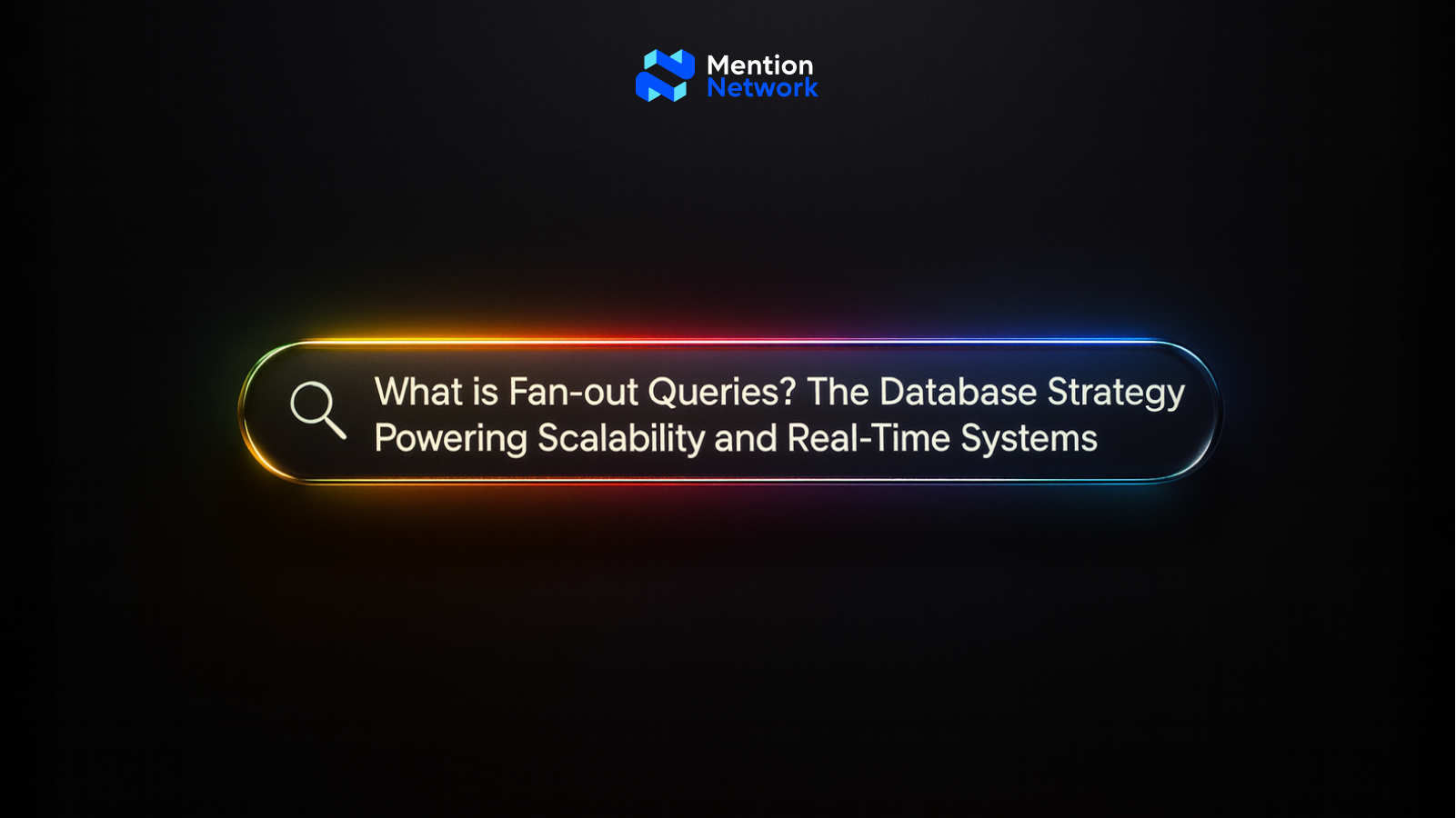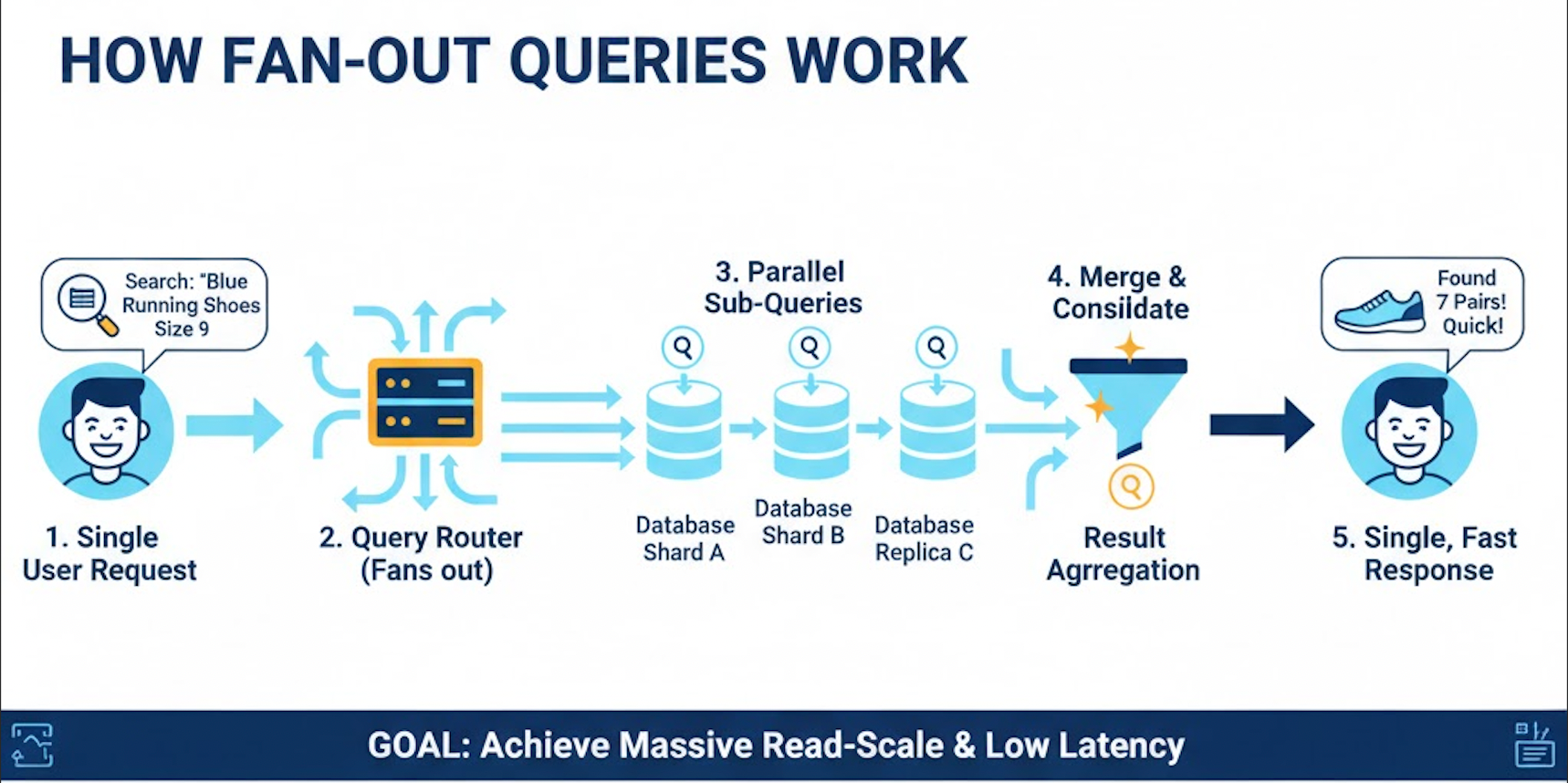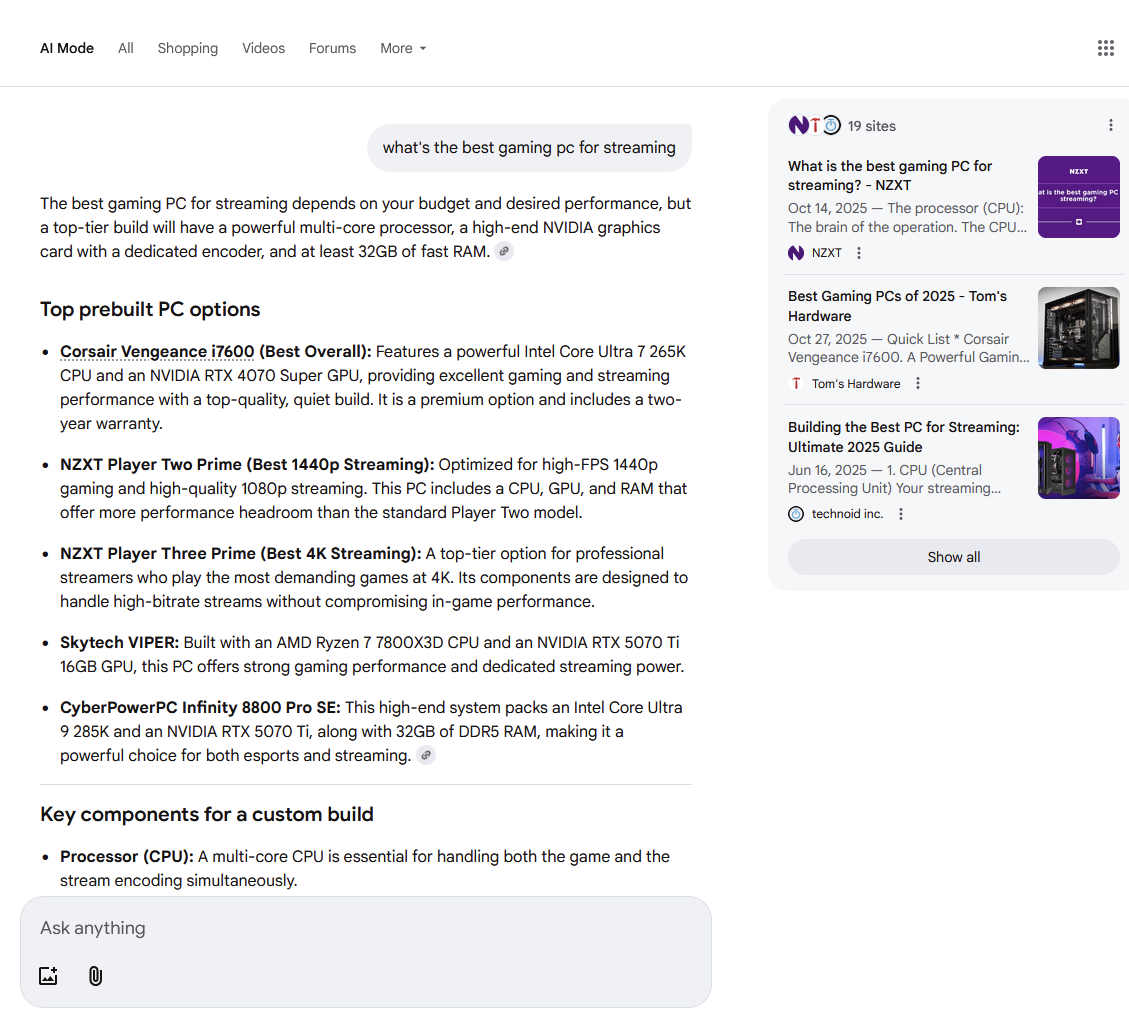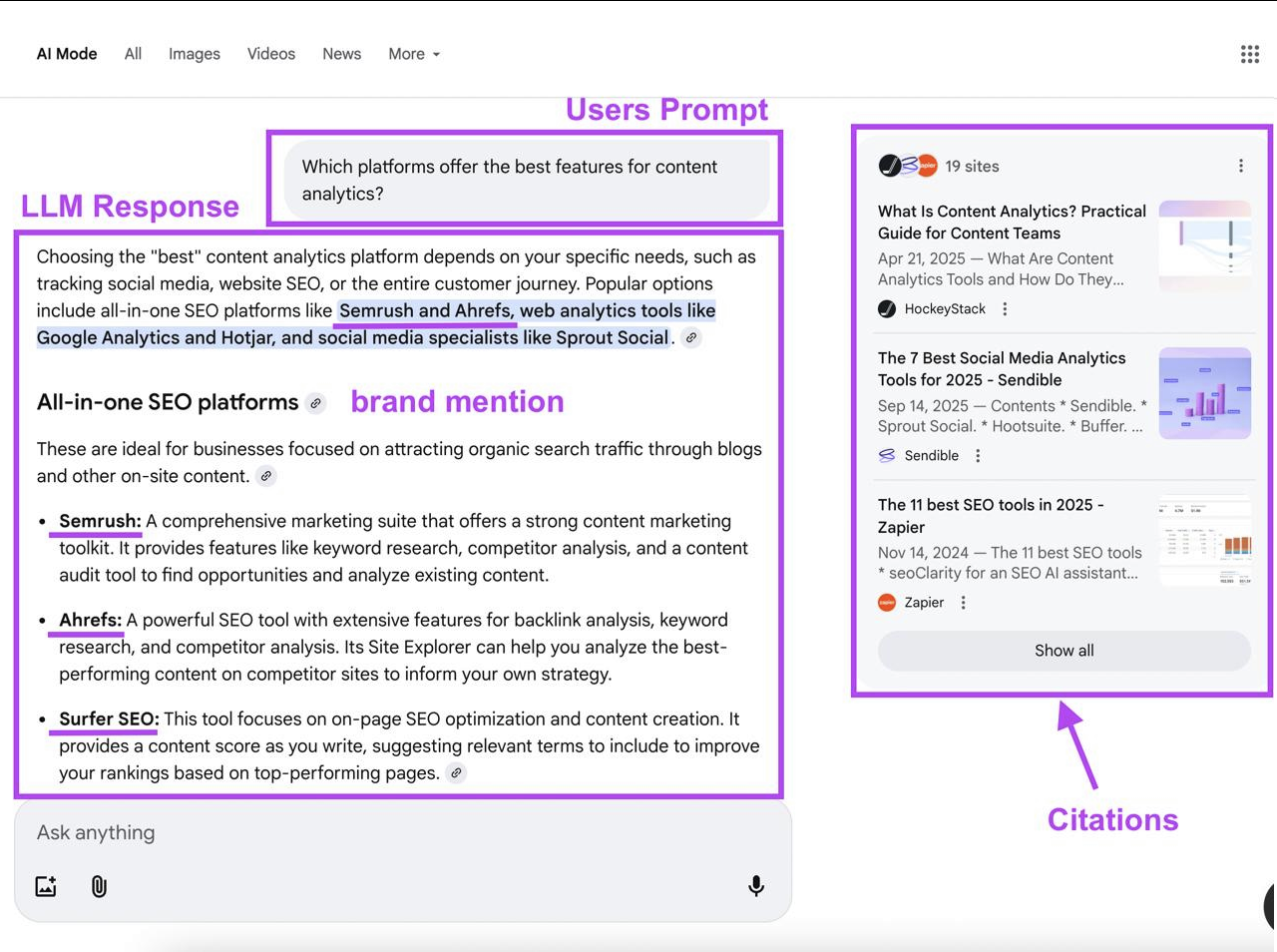What is Fan-out Queries? The Database Strategy Powering Scalability and Real-Time Systems

What Is Query Fan-Out?
A Fan-out Query is a technique used in large, distributed data systems (like social media platforms or e-commerce sites).
In short:
- The Problem: When too many people search for information simultaneously, a single central server gets overwhelmed and slow.
- The Solution: Modern systems split their data and store it across multiple smaller, dedicated servers (distribution).
- The Fan-out Action: When you submit a single search request, the system "Fans-out" that query. This means it doesn't ask one server after another, but sends the same small question to all relevant servers at the exact same time.
- Consolidation: After receiving the individual answers from every server, the system merges them into one comprehensive, single result and delivers it back to you.
This technique enables the system to handle millions of data read requests concurrently in an extremely fast manner (parallel processing), ensuring speed and stability for massive-scale applications.
AI search systems (also known as LLMs) like Google AI Mode and ChatGPT use query fan-out to improve the quality of their responses.
Here’s an example of how query fan-out works:

Query Fan-Out in Google AI Mode
Google brought the term "query fan-out" into the public eye when they unveiled Google AI Mode, the conversational AI interface integrated directly into Google Search.
During the Google I/O 2025 keynote speech, Head of Search, Elizabeth Reid, offered this explanation:
"AI Mode isn’t just giving you information, it’s bringing a whole new level of intelligence to search. What makes this possible is something we call our query fan-out technique."
"Now, under the hood, Search recognizes when a question needs advanced reasoning. It calls on our custom version of Gemini to break the question into different subtopics, and it issues a multitude of queries simultaneously on your behalf.
When you search using Google AI Mode, you may notice the model executes multiple web searches as part of its internal reasoning process.
In this specific example, Google appears to have successfully split the user's original query into 19 distinct searches and provide a highly specific response

While traditional search focuses on finding the best direct keyword match for a query, this example shows why a perfectly satisfactory result doesn't always exist.

Why Query Fan-Out is Crucial for Marketers
Query fan-out fundamentally matters in marketing because it allows AI systems to produce highly specific, synthesized responses, potentially reducing a user's need to click through to other sources.
This capability means AI-generated answers wield enormous influence over consumer decisions. Ensuring your brand is featured favorably in relevant conversations is key to reaching and engaging your audience, especially as AI adoption continues to rise.
By optimizing your content for query fan-out, you can significantly increase your AI Visibility through two primary outcomes:
- AI Mentions: Direct mentions of your business or brand within the AI's synthesized response.
- AI Citations: Linked references that point directly to your content, displayed alongside the AI's answer (as seen in the example below with ChatGPT).

Because query fan-out operates differently than traditional search algorithms, it requires a specialist content approach. The good news is that optimizing for fan-out often boosts your performance in traditional search results as well.
How to Optimize Your Website for Query Fan-Out and Win AI Visibility
To successfully optimize for query fan-out, you need a disciplined approach that goes beyond traditional SEO. You must identify core topics, cover them completely, write for Natural Language Processing (NLP), and leverage structured data. This strategic content architecture, combined with general LLM optimization best practices, is the foundation for increased AI visibility.
1. Identify and Define Core Topics
Start by figuring out the core areas where you want your brand to be the authoritative source for AI systems. Focusing your optimization efforts effectively is key.
I recommend beginning with topics directly related to your business and its offerings. This laser focus helps you:
- Control the Brand Narrative: You get to shape how your brand is accurately portrayed in AI-generated responses (AI Mentions).
- Influence the Buyer’s Journey: Your content appears during critical research stages where visibility matters most.
- Leverage Authority: These are the areas where you are undeniably the expert, giving the AI a strong trust signal.
For instance, you might use a tool like Mention Network’s AI SEO Toolkit to pinpoint your most impactful brand topics. If you discover users are more interested in your company's social responsibility efforts than its technology innovations, you should prioritize that content.
Once your brand-related topics are solid, expand outward into related areas that align with your expertise. Always prioritize based on your business goals and audience needs. For example, Mention Network publishes content about their digital marketing tools and broader digital marketing topics because their authority extends to both.
2. Plan Comprehensive Topic Clusters
AI systems value complete, deep knowledge. Topic Clusters groups of tightly interlinked web pages are how you demonstrate that expertise.
A cluster consists of:
- A central Pillar Page offering a broad, authoritative overview of the core topic.
- Several Cluster Pages that dive deeply into relevant subtopics.
Why Clustering Works for Fan-Out: Topic clustering allows you to address the multitude of sub-queries generated during a query fan-out. By covering all angles, you maximize the chance that multiple parts of your content will be featured in the AI's response, which also helps you build topical authority and encourages AI systems to prioritize your answers.
3. Create Helpful, Comprehensive Content
To satisfy the diverse sub-queries that result from query fan-out, your content must be exceptionally helpful and comprehensive.
The goal is to break down each subtopic into even more granular questions and address these specific intents directly within the subsections of your page.
You can identify these specific user intents by:
- Performing Keyword Research: Use tools to see the exact long-tail queries people type into search.
- Analyzing Competitors: See which questions your rivals answer in their FAQs or dedicated sections.
- Exploring Online Communities: Check forums and social platforms for recurring user questions.
- Consulting Your Team: Ask your customer service or sales teams about common user inquiries.
If you use specialized tools like the Mention Network AI SEO Toolkit, you can discover specific brand-related questions people ask directly in LLMs. Addressing these high-value queries directly influences customers at pivotal stages of their buying journey.
4. Write for Natural Language Processing (NLP)
AI systems rely on Natural Language Processing (NLP) to accurately understand and extract facts from written content. Your writing must be optimized for this process to ensure visibility.
Here are the essential tips for writing for NLP:
- Write in Chunks: Use self-contained, meaningful sections of content that can stand alone. These "chunks" are easier for an AI to process, retrieve, and summarize. Always write in full sentences and restate context where it’s helpful.
- Provide Direct Definitions: When introducing a new concept, provide a clear, direct definition. AI systems may seek out these definitions as part of the fan-out process to establish context.
- Structure Content Effectively: Use descriptive subheadings and proper heading tags (H2, H3) to clearly signal the content hierarchy. Tables and lists are excellent for creating easily parsable information that the AI can quickly extract.
- Use Clear Language: Keep your language clear and conversational. Avoid unnecessary jargon, overly complex sentence structures, and filler words. Simplicity makes your content more accessible to the AI.
5. Use Schema Markup
Schema Markup allows you to add machine-readable labels to data on your page. This is critical because it helps AI systems interpret your content with absolute accuracy.
For example, you can use Product schema to label a product’s name and image, and Offer schema to label the price and availability. This explicit labeling makes it significantly easier for AI systems to extract the exact facts needed when answering complex, product-related fan-out queries.
Refer to Schema.org to find the specific schema types relevant to your business (e.g., Article, Organization, HowTo) and learn how to implement this structured data correctly. This is the final layer of optimization that guarantees machine-level clarity.
Conclusion
With the query fan-out technique, Google’s AI Mode has fundamentally changed the game: it rewards high-context content, not just high rankings. Every single search is now fragmented into a web of micro-questions. If your content doesn't directly address these micro-intents, it simply won't be cited, no matter how much traditional SEO you've done.
The complexity is manageable, and you don't need to rely on guesswork.
Tools like Mention Network provide the visibility you need to succeed in AI search. You can see precisely where your brand is showing up, analyze the sentiment of AI-generated brand mentions, and identify optimization gaps. Mention Network helps you fine-tune your strategy for the future of search. If dominating AI-generated answers is your priority, Mention Network belongs in your marketing toolkit.
FAQs
Is Query Fan-Out the same thing as traditional SEO?
No. Traditional SEO focuses on matching keywords and building links to increase a page's overall rank. Query fan-out focuses on structuring specific content chunks so that an AI can easily and accurately extract a small, verifiable fact to include in a synthesized answer.
What is the most critical factor for influencing an AI’s synthesized response?
The most critical factor is Topical Authority combined with Content Structure. The AI must first trust your domain as an expert on the subject (which topic clusters build), and then your content must be structured using clear headings, definitions, lists, and Schema Markup so that the AI can quickly and confidently extract the specific piece of data it needs to answer one of its sub-queries.
Should I stop writing for humans and only write for NLP?
No. The best content strikes a balance. The goal is to use clear, conversational language (which humans prefer) while simultaneously structuring that content with headings, lists, and Schema (which machines prefer). Good NLP-optimized content should be equally easy for a person to read and for an AI to parse.

